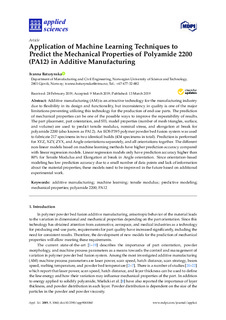| dc.contributor.author | Baturynska, Ivanna | |
| dc.date.accessioned | 2019-04-03T07:46:08Z | |
| dc.date.available | 2019-04-03T07:46:08Z | |
| dc.date.created | 2019-03-14T07:44:33Z | |
| dc.date.issued | 2019 | |
| dc.identifier.citation | Applied Sciences. 2019, . | nb_NO |
| dc.identifier.issn | 2076-3417 | |
| dc.identifier.uri | http://hdl.handle.net/11250/2593045 | |
| dc.description.abstract | Additive manufacturing (AM) is an attractive technology for the manufacturing industry due to flexibility in its design and functionality, but inconsistency in quality is one of the major limitations preventing utilizing this technology for the production of end-use parts. The prediction of mechanical properties can be one of the possible ways to improve the repeatability of results. The part placement, part orientation, and STL model properties (number of mesh triangles, surface, and volume) are used to predict tensile modulus, nominal stress, and elongation at break for polyamide 2200 (also known as PA12). An EOS P395 polymer powder bed fusion system was used to fabricate 217 specimens in two identical builds (434 specimens in total). Prediction is performed for XYZ, XZY, ZYX, and Angle orientations separately, and all orientations together. The different non-linear models based on machine learning methods have higher prediction accuracy compared with linear regression models. Linear regression models only have prediction accuracy higher than 80% for Tensile Modulus and Elongation at break in Angle orientation. Since orientation-based modeling has low prediction accuracy due to a small number of data points and lack of information about the material properties, these models need to be improved in the future based on additional experimental work. | nb_NO |
| dc.language.iso | eng | nb_NO |
| dc.publisher | MDPI | nb_NO |
| dc.rights | Navngivelse 4.0 Internasjonal | * |
| dc.rights.uri | http://creativecommons.org/licenses/by/4.0/deed.no | * |
| dc.title | Application of Machine Learning Techniques to Predict the Mechanical Properties of Polyamide 2200 (PA12) in Additive Manufacturing | nb_NO |
| dc.type | Journal article | nb_NO |
| dc.type | Peer reviewed | nb_NO |
| dc.description.version | publishedVersion | nb_NO |
| dc.source.pagenumber | 20 | nb_NO |
| dc.source.journal | Applied Sciences | nb_NO |
| dc.identifier.doi | https://doi.org/10.3390/app9061060 | |
| dc.identifier.cristin | 1684628 | |
| dc.description.localcode | © 2019 by the author. Licensee MDPI, Basel, Switzerland. This article is an open access article distributed under the terms and conditions of the Creative Commons Attribution (CC BY) license (http://creativecommons.org/licenses/by/4.0/). | nb_NO |
| cristin.unitcode | 194,64,94,0 | |
| cristin.unitname | Institutt for vareproduksjon og byggteknikk | |
| cristin.ispublished | false | |
| cristin.fulltext | postprint | |
| cristin.qualitycode | 1 | |

